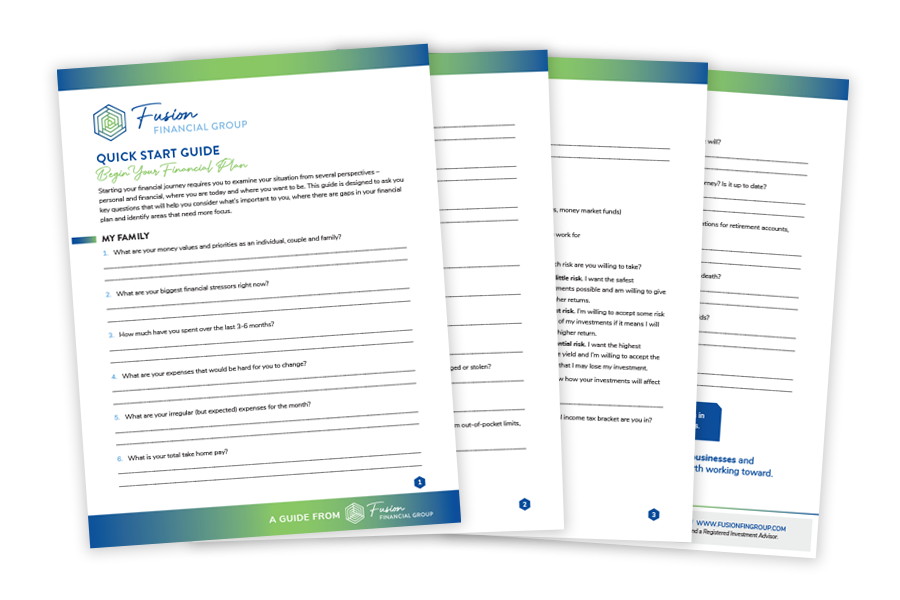Markets are always forward looking, so it’s important to remain focused on what lies ahead. There will most certainly be challenges, but there are also some tailwinds from a strong job market, still resilient businesses, and the likelihood that inflation will soon start to slow.
OVERVIEW
Markets rarely give us clear skies, and there are always threats to watch for on the horizon, but the right preparation, context, and support can help us navigate anything that may lie ahead. So far, this year hasn’t seen a full-blown crisis like 2008–2009 or 2020, but the ride has been very bumpy. We may not be flying into a storm, but there’s been plenty of turbulence the first part of 2022. How businesses, households, and central banks steer through the rough air will set the tone for markets over the second half of 2022.
The sources of turbulence are clear. A global economy that was already vulnerable to inflation from supply chain disruptions, tight labor markets, excess stimulus, and loose monetary policy came under more pressure when Russian aggression in Ukraine added sharply rising commodity prices and pushed Europe into what may be the brink of a recession. The effects have included renewed pressure on interest rates, which hurt bond investors and contributed to tightening financial conditions, and a much more aggressive stance by the Federal Reserve (Fed) and other global central banks. Add in the typical market challenges of a midterm election year and the third year of a bull market, and it’s not surprising it’s been a bumpy ride.
Understandably, rising prices, slowing economic growth, and a challenging first half for both stocks and bonds have many investors on edge, and fatigue from more than two years of COVID-19 measures doesn’t make it any easier. But markets are always forward looking, so it’s important to remain focused on what lies ahead. There will most certainly be challenges, but there are also some tailwinds from a strong job market, still resilient businesses, and the likelihood that inflation will soon start to slow. Markets historically can even get a little lift from lower uncertainty around elections as midterms approach.
Turbulence cannot be avoided, but it also need not deter us from making progress toward our financial goals. LPL Research’s Midyear Outlook 2022: Navigating Turbulence is designed to help you assess conditions over the second half of the year, alert you to the challenges that may still lie ahead, and help you find the smoothest path for making continued progress toward your destination. When times are turbulent, the surest path toward progress remains sound financial advice from dedicated professionals who have logged many hours in similar conditions. Please reach out to me with any questions.
ECONOMY
We believe the domestic economy will continue to grow this year, albeit slower than we expected six months ago. Other than the anomaly of a negative print in first quarter gross domestic product (GDP), we think the economy has sufficient momentum to offset the inflationary pressures. Our base case forecast includes an inflation rate that moderates as supply bottlenecks improve and we potentially get some closure to the Russian war with Ukraine. Our most likely scenario is the economy avoids an official recession, as growth is expected to notch just above 2% in 2022 with another downshift to under 2% in 2023. These are annual figures so intra-year economic activity could be quite volatile as the Fed becomes more aggressive in the tightening cycle.
INFLATION
Inflation will most likely be significantly above the Fed’s long-run target of 2%. Inflation rates will likely cool throughout this year, but the cool down period will be long and slow. Some inflation pressures should subside as China adjusts its COVID-19 policy and supply chains improve. A slowing housing market could also eventually ease inflationary pressures later this year and into 2023.
STOCKS
Stocks will face a number of headwinds in the second half of the year, but the amount of turbulence will likely depend on the pace at which inflation falls. Volatility may persist, but an improved macroeconomic environment may set the stage for higher valuations, further earnings growth, and solid gains for stocks over the rest of the year. The challenge comes from predicting how fast inflation will come down. Our year-end fair value target for the S&P 500 is 4,300–4,400, based on a price-to-earnings ratio of 18–19 and our 2023 S&P 500 earnings per share forecast of $235.
BONDS
The value proposition for core bonds is that they tend to provide liquidity, diversification, and positive total returns to portfolios. Unfortunately, none of those values is 100% certain all the time. Like all markets, fixed income investing involves risks and, at times, negative returns. However, despite the historically poor start to the year, the value proposition for core bonds has actually improved recently. With the big jump in yields that has already taken place this year, we believe core bonds look as good as they have in quite some time. As rate hikes work their way through the economy and slower growth starts to get priced in, we could see the 10-year Treasury yield end the year between 2.75–3.25%.
POLICY
One of the things we knew coming into this year was that 2022 will be a midterm year—and those have historically not been kind to stocks. In fact, since 1950, midterm years have seen the largest peak-to-trough pullback of the four years of the presidential cycle, with the S&P 500 Index down 17.1% on average during the year. The good news is, one year off those lows, stocks have been up more than 32% on average. And the S&P 500 has been higher a year after every midterm election since 1950—18 out of 18 years—with an average gain one year later a very solid 14.5%. It looks like a divided government is in the cards, which markets have historically liked.
ALTERNATIVES
Losses across both stock and bond markets in 2022 have left many searching for ways to further diversify exposures. While alternatives cover a wide range of approaches, several have helped fill that gap, and may continue to do so over the rest of the year. We continue to believe our preferred alternatives implementations—event-driven strategies, market neutral strategies, and relatively conservative low volatility strategies—have the ability to act as a source of ballast during such periods of high volatility.
COMMODITIES
Commodities have garnered support from both demand and supply, and we believe upward pressure on prices will likely persist for at least the next several months. Demand has gotten a lift as the global economy emerged from the pandemic. Sanctions on Russian energy exports have kept oil and gas prices elevated. Ukraine is an important global supplier of agricultural commodities such as corn and wheat, putting upward pressure on food prices. From an investment perspective, we would favor energy.
CURRENCIES
As we enter the second half of 2022, the factors that led to a sharp and nearly uninterrupted ascent for the U.S. dollar such as a hawkish Fed and demand for safe havens may begin to reverse. In the intermediate term, easing inflation from unsnarling of supply chains post-COVID-19, aided by China’s reopening, could help push the dollar lower.
The opinions, statements and forecasts presented herein are general information only and are not intended to provide specific investment advice or recommendations for any individual. It does not take into account the specific investment objectives, tax and financial condition, or particular needs of any specific person. There is no assurance that the strategies or techniques discussed are suitable for all investors or will be successful. To determine which Investment(s) may be appropriate for you, please consult your financial professional prior to investing.
Any forward-looking statements including the economic forecasts herein may not develop as predicted and are subject to change based on future market and other conditions. All performance referenced is historical and is no guarantee of future results.
References to markets, asset classes, and sectors are generally regarding the corresponding market index. Indexes are unmanaged statistical composites and cannot be invested into directly. Index performance is not indicative of the performance of any investment and does not reflect fees, expenses, or sales charges. All performance referenced is historical and is no guarantee of future results.
Alternative investments may not be suitable for all investors and should be considered as an investment for the risk capital portion of the investor’s portfolio. The strategies employed in the management of alternative investments may accelerate the velocity of potential losses.
Event driven strategies, such as merger arbitrage, consist of buying shares of the target company in a proposed merger and fully or partially hedging the exposure to the acquirer by shorting the stock of the acquiring company or other means. This strategy involves significant risk as events may not occur as planned and disruptions to a planned merger may result in significant loss to a hedged position.
Any company names noted herein are for educational purposes only and not an indication of trading intent or a solicitation of their products or services. LPL Financial doesn’t provide research on individual equities.
There is no guarantee that a diversified portfolio will enhance overall returns or outperform a non-diversified portfolio. Diversification does not protect against market risk.
The fast price swings in commodities will result in significant volatility in an investor’s holdings. Commodities include increased risks, such as political, economic, and currency instability, and may not be suitable for all investors. All index data from FactSet.
All information is believed to be from reliable sources; however, LPL Financial makes no representation as to its completeness or accuracy.
Investing involves risks including possible loss of principal. No investment strategy or risk management technique can guarantee return or eliminate risk in all market environments. There is no guarantee that a diversified portfolio will enhance overall returns or outperform a non-diversified portfolio. Diversification does not protect against market risk. Investing in foreign and emerging markets debt or securities involves special additional risks. These risks include, but are not limited to, currency risk, geopolitical risk, and risk associated with varying accounting standards. Investing in emerging markets may accentuate these risks.
Gross Domestic Product (GDP) is the monetary value of all the finished goods and services produced within a country’s borders in a specific time period, though GDP is usually calculated on an annual basis. It includes all of private and public consumption, government outlays, investments and exports less imports that occur within a defined territory.
The PE ratio (price-to-earnings ratio) is a measure of the price paid for a share relative to the annual net income or profit earned by the firm per share. It is a financial ratio used for valuation: a higher PE ratio means that investors are paying more for each unit of net income, so the stock is more expensive compared to one with lower PE ratio.
Earnings per share (EPS) is the portion of a company’s profit allocated to each outstanding share of common stock. EPS serves as an indicator of a company’s profitability.
Earnings per share is generally considered to be the single most important variable in determining a share’s price. It is also a major component used to calculate the price-to-earnings valuation ratio.
The Standard & Poor’s 500 Index is a capitalization-weighted index of 500 stocks designed to measure performance of the broad domestic economy through changes in the
aggregate market value of 500 stocks representing all major industries.
The Bloomberg U.S. Aggregate Bond Index is an index of the U.S. investment-grade fixed-rate bond market, including both government and corporate bonds.
Investing in stock includes numerous specific risks including the fluctuation of dividend, loss of principal and potential illiquidity of the investment in a falling market. Because of their narrow focus, sector investing will be subject to greater volatility than investing more broadly across many sectors and companies. Value investments can perform differently from the market as a whole. They can remain undervalued by the market for long periods of time. The prices of small and mid-cap stocks are generally more volatile than large cap stocks.
Cyclical stocks typically relate to equity securities of companies whose price is affected by ups and downs in the overall economy and that sell discretionary items that consumers may buy more of during an economic expansion but cut back on during a recession. Counter-cyclical stocks tend to move in the opposite direction from the overall economy and with consumer staples which people continue to demand even during a downturn.
A Growth stock is a share in a company that is anticipated to grow at a rate significantly above the average for the market due to capital appreciation.
A Value stock is anticipated to grow above the average for the market due to trading at a lower price relative to its fundamentals, such as dividends, earnings, or sales.
Large cap stocks are issued by corporations with a market capitalization of $10 billion or more, and small cap stocks are issued by corporations with a market capitalization between $250 million and $2 billion.
Bonds are subject to market and interest rate risk if sold prior to maturity. Bond values will decline as interest rates rise and bonds are subject to availability and change in price. Bond yields are subject to change. Certain call or special redemption features may exist which could impact yield. Government bonds and Treasury bills are guaranteed by the U.S. government as to the timely payment of principal and interest and, if held to maturity, offer a fixed rate of return and fixed principal value. Corporate bonds are considered higher risk than government bonds but normally offer a higher yield and are subject to market, interest rate, and credit risk, as well as additional risks based on the quality of issuer coupon rate, price, yield, maturity, and redemption features. Mortgage-backed securities are subject to credit, default, prepayment, extension, market and interest rate risk.
Credit Quality is one of the principal criteria for judging the investment quality of a bond or bond mutual fund. As the term implies, credit quality informs investors of a bond or bond portfolio’s credit worthiness, or risk of default. Credit ratings are published rankings based on detailed financial analyses by a credit bureau specifically as it relates to the bond issue’s ability to meet debt obligations. The highest rating is AAA, and the lowest is D. Securities with credit ratings of BBB and above are considered investment grade. The credit spread is the yield the corporate bonds less the yield on comparable maturity Treasury debt. This is a market-based estimate of the amount of fear in the bond market. Base-rated bonds are the lowest quality bonds that are considered investment-grade, rather than high-yield. They best reflect the stresses across the quality spectrum.
The Bloomberg Aggregate U.S. Bond Index represents securities that are SEC-registered, taxable, and dollar denominated. The index covers the U.S. investment-grade fixed rate bond market, with index components for government and corporate securities, mortgage pass-through securities, and asset-backed securities.
High yield/junk bonds (grade BB or below) are not investment grade securities, and are subject to higher interest rate, credit, and liquidity risks than those graded BBB and above. They generally should be part of a diversified portfolio for sophisticated investors.
Municipal bonds are subject to availability and change in price. They are subject to market and interest rate risk if sold prior to maturity. Bond values will decline as interest rates rise. Interest income may be subject to the alternative minimum tax. Municipal bonds are federally tax-free but other state and local taxes may apply. If sold prior to maturity, capital gains tax could apply.
This material was prepared by LPL Financial, LLC.
Securities and advisory services offered through LPL Financial (LPL), a registered investment advisor and broker-dealer (member FINRA/SIPC).
Insurance products are offered through LPL or its licensed affiliates. To the extent you are receiving investment advice from a separately registered independent investment advisor that is not an LPL affiliate, please note LPL makes no representation with respect to such entity.
Tracking #1-05292601 (Exp. 07/23)



